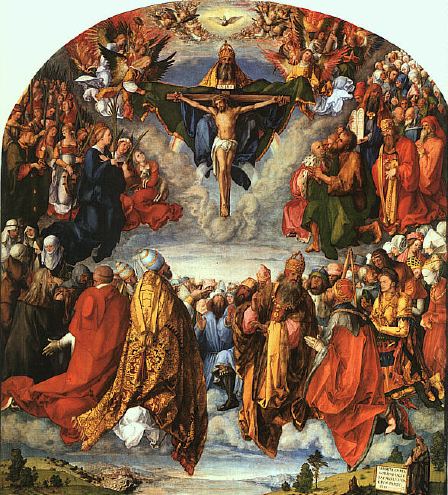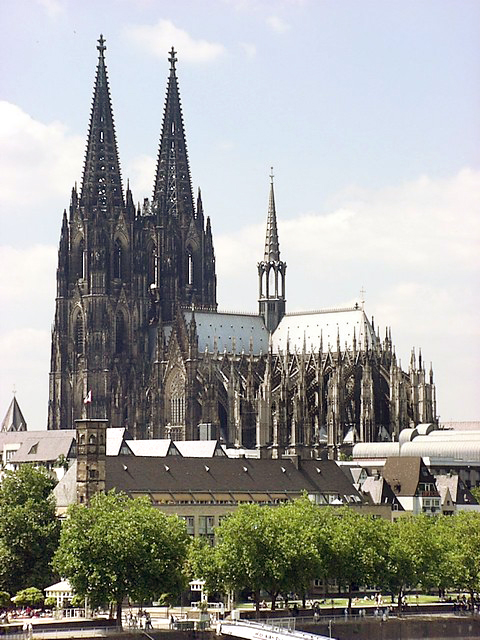The medievalist C. S. Lewis could not shake the idea of purgatory—the place of final sanctification before the judgment. He believed it, though not (he said) in its full Roman Catholic panoply. This came partly from a seriousness about sin: surely none of us thinks we can stand before a holy God after death without some sort of cleansing! But the deeper grounding of the doctrine for Lewis as for the medievals is this: Our life is a breath; a blade of grass; a brief, transitory phase between birth and death; a twinkle in time compared to eternal life with God in heaven, or eternal damnation without God and with Satan in hell. You want to live it as well as you can, and when it comes time to die, you want to be as prepared as possible to meet your eternal destiny. While we moderns covet a quick, painless death, the medievals prayed that they would not be overtaken suddenly. Deaths were very public, social: you died surrounded by family and friends—people came, talked to you, you settled grievances with them and wept and prayed with them. How different from the modern desire to hide death behind hospital curtains, extending its sterile solitude with fluid flowing down tubes. For medievals, death was the culmination of life—the launching or entrance into the eternal world. All this was explained in an important late-medieval genre: the plentiful manuals teaching the “art of dying well”—the Ars Moriendi.
Thanks for visiting my historical playground!
This blog contains over 720 posts as of Oct 2020 (also over 518,000 views from 210,000 unique visitors since inception in June 2010). If you read something you like, odds are there are at least one or two other posts dealing with similar topics. Which is why there’s a search box right below this message. :)
Find posts by search term(s)
my book
Follow “gratefultothedead” on www.twitter.com:
Tweets by gratefultodeadWhat folks are reading most lately
- C. S. Lewis on pagan philosophy as a road to Christian faith
- C S Lewis's spiritual formation: confession, purgatory, Mary, and other Catholic dimensions
- St Francis of Assisi: Redefining discipleship
- Quote of the day: "Scripture is like a river . . . broad and deep, shallow enough here for the lamb to go wading, but deep enough there for the elephant to swim."
- Doctrinalist, pietist, culturalist. How does your church lean?
- The seven deadly sins: Gregory the Great
-
Join 981 other subscribers
-
What we’ve been talking about lately
- We’ve moved! Don’t miss current posts . . .
- Whither beauty, goodness, and truth in the modern American church?
- Spirituality and economic work in the Middle Ages: Complementarity, not enmity? Part X – the Cistercian example (III)
- Five themes in Christian humanism (IV – final)
- Five themes in Christian humanism (III)
- Five themes in Christian humanism (II)
- Five themes in Christian humanism (I)
- Spirituality and economic work in the Middle Ages: Complementarity, not enmity? Part IX – the Cistercian example (II)
- Does “Christian humanism” even exist? Is anyone really talking about it? Part I
- Spirituality and economic work in the Middle Ages: Complementarity, not enmity? Part VIII – the Cistercian example (I)
- Christian humanism seminar outline (follow-up to the “sketch”)
- A sketch toward a seminar on Christian humanism
- Reading CS Lewis’s medieval retrieval as a Christian humanism for today
- Spirituality and economic work in the Middle Ages: Complementarity, not enmity? Part VII
- Spirituality and economic work in the Middle Ages: Complementarity, not enmity? Part VI
- Spirituality and economic work in the Middle Ages: Complementarity, not enmity? Part V
- Spirituality and economic work in the Middle Ages: Complementarity, not enmity? Part IV
- Spirituality and economic work in the Middle Ages: Complementarity, not enmity? Part III
- Spirituality and economic work in the Middle Ages: Complementarity, not enmity? Part II
- Spirituality and economic work in the Middle Ages: Complementarity, not enmity? Part I
Comments
Blogroll
- A Holy Renaissance
- Above Every Name
- Andy Rowell
- Christian History magazine
- Christian intel daily
- Christian thought & culture (Kyle Roberts)
- Christianity & Western Civilization: The Radio Show
- Cloud of Witnesses
- Cole Matson: The Unicorn Triumphant
- Don Merritt's LifeReference blog
- Here I Walk
- History Makers
- Jesus Radicals
- Magdalena Perks: Anglicans, Plain
- Medieval History Geek
- Michael Cline–Recliner Ramblings
- Reclaiming the mind
- Religion in American History
- scientia et sapientia
- Scot McKnight–Jesus Creed
- Stand Fast in Faith
- Steve Gertz "All Things Halal"
- Tea at Trianon
- The birdseed desk
- The Christian Humanist
- The Discarded Image
- The History of the (Whole) World
- The MacLaurin Institute
- The Neff Review
- The Pietist Schoolman
- The Scriptorium Daily
- Theology PhD Mom
- Tony Siew–Revelation is real
- Travis Lambert
- Trevin Wax
Historically delicious sites
my book
Browse a category with this dropdown list
- African-American Christianity Aristotle asceticism Augustine Augustine of Hippo Authorized King James Version Benedict of Nursia Bible black church Boethius Charles Williams Christ and culture Christian history Christian History magazine Christian humanism Creation C S Lewis CS Lewis Dante Alighieri Dorothy L Sayers Dorothy Sayers Early Christianity early church economics education embodiedness embodiment emotion ethics Eucharist evangelicalism faith and reason faith and work Francis of Assisi G K Chesterton Gregory the Great healing hospitals Incarnation John Wesley Jonathan Edwards J R R Tolkien literature Martin Luther medicine Medieval Methodism Middle Ages missions monasticism morality moral philosophy Pentecostalism philosophy Pietism poverty prayer Protestantism Roman Catholicism sacramentalism sacramentality sanctification scholasticism science scientific revolution sex sin social justice Spirituality Theology the poor Thomas Aquinas Tradition vocation work
Month-by-month archives
Blog Stats
- 559,590 hits

We share with all the saints one Lord

Francis of Assisi--part of an altarpiece by Bartolomeo Vivarini, in the Brooklyn Museum

From a mid-15th-century Dutch prayerbook: Saint James the Great; Saint Joseph; Saint Ghislain, abbot of St Ghislain, near Mons; Saint Eligius; Saint Ermes (Hermes)

Gregory the Great and St. Mamertinus, from a 14th-century French translation of Jacobus de Voragine, Legenda aurea

Cologne Cathedral

The clocktower of the Saint-Leu-Saint-Gilles church in Saint-Leu-la-Forêt (Val-d'Oise), France

Masaccio, Crucifixion, 1426 (Naples, Museo Nazionale di Capodimonte); the blonde figure is Mary Magdalen

Door of Tewkesbury Abbey cloister

 Medieval Wisdom for Modern Christians
Medieval Wisdom for Modern Christians
“There is only one end for those that die in their sins. Everlasting punishment.”
Wow. Then there is no hope for any of us. For who can say we are pure (not “in our sins”) at our death?
Everyone that is born of God can say so boldly for the Word of God says…
We know that whosoever is born of God sinneth not; but he that is begotten of God keepeth himself, and that wicked one toucheth him not. 1 John 5:18
A sin-free life is a distinguishing mark all the children of God have.
Whosoever is born of God doth not commit sin; for his seed remaineth in him: and he cannot sin, because he is born of God. In this the children of God are manifest, and the children of the devil: whosoever doeth not righteousness is not of God, neither he that loveth not his brother. 1 John 3:9-10
God loves us and keeps us from those things that are too much for us to resist. Therefore the only way we can turn back to sin is if we desire to.
There hath no temptation taken you but such as is common to man: but God is faithful, who will not suffer you to be tempted above that ye are able; but will with the temptation also make a way to escape, that ye may be able to bear it. 1 Corinthians 10:13
The reality is that we will die just how we lived and meet God just as we were at death. Paul confirms, And as it is appointed unto men once to die, but after this the judgment: Hebrews 9:27
Forgive me, calledsoldiers, but I don’t see how the verse appended to your comment proves your point (if indeed it was intended to). It certainly seems to leave room for a post-death purgative process. Now, I’m not sure I follow Lewis on purgatory, but I think the conversation is a valuable one. I invite your response to mine. 🙂
Well I thought sure it was written out very plainly. Once to die… after this… You die then after this the judgment. Does that leave room. After you die the judgment.
Perhaps more verses will help…
Then said Jesus again unto them, I go my way, and ye shall seek me, and shall die in your sins: whither I go, ye cannot come. John 8:21
For if we sin wilfully after that we have received the knowledge of the truth, there remaineth no more sacrifice for sins, But a certain fearful looking for of judgment and fiery indignation, which shall devour the adversaries. Hebrews 10:26-27
There is only one end for those that die in their sins. Everlasting punishment.